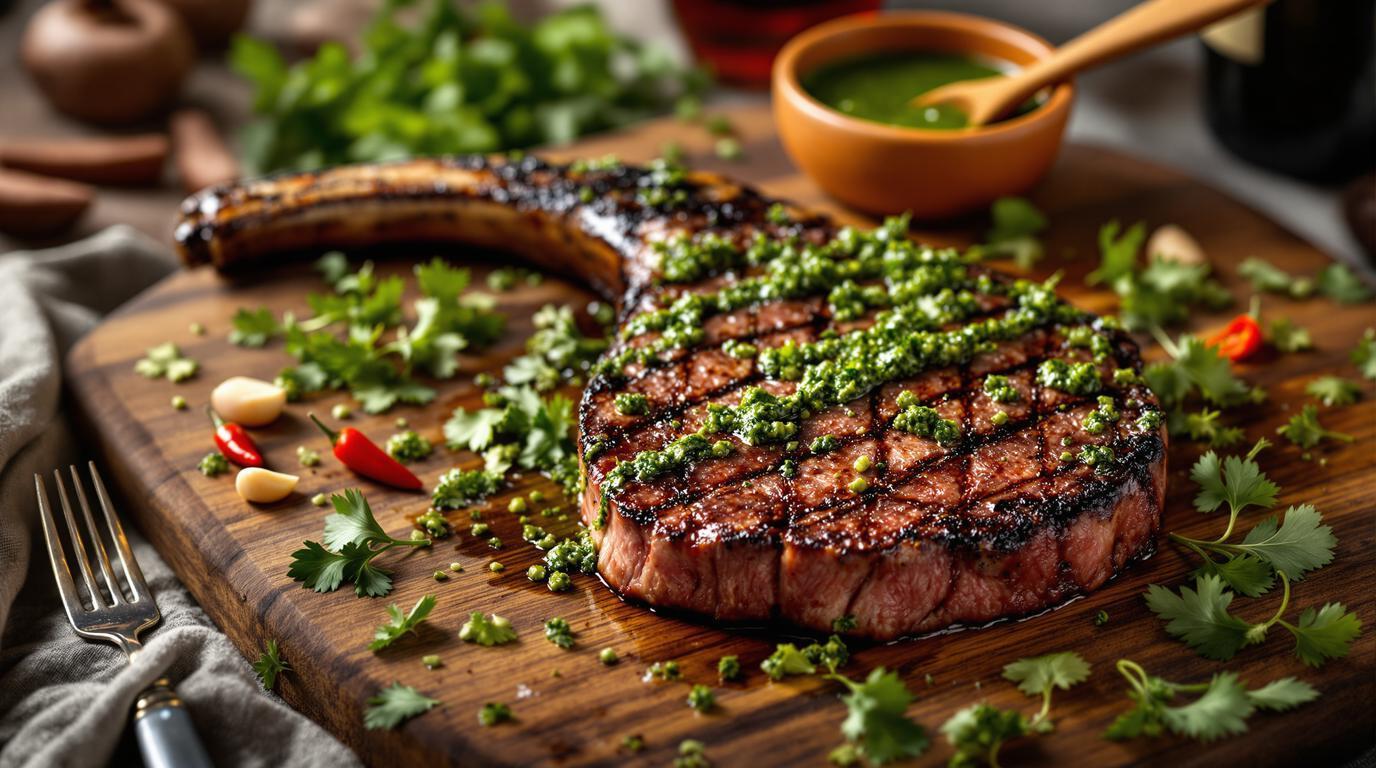The first time I encountered authentic chimichurri in Argentina, I was struck by its vibrant simplicity. Standing beside an asador (grill master) outside Buenos Aires, I watched him spoon this electric green sauce over perfectly charred beef, releasing an intoxicating cloud of garlic and herbs. What surprised me most wasn’t the ingredients—which are remarkably straightforward—but how dramatically this uncooked sauce transformed the meat. The balance of acidic vinegar cutting through rich fat creates what I consider the perfect flavor harmony for grilled meats, especially a magnificent Tomahawk steak.
The Story Behind Chimichurri 📖
Chimichurri is the beating heart of Argentine asado (barbecue). While food historians debate its exact origins—some credit an Irish immigrant named “Jimmy Curry,” others point to Basque influences—what’s undeniable is its essential role in Argentina’s grilling tradition. Unlike processed condiments, chimichurri celebrates raw, vibrant flavors that awaken the palate between bites of rich meat. I’ve experimented with countless variations across South America, but the traditional Argentine version remains my gold standard for its perfect simplicity.
Ingredients Spotlight 🧪
The beauty of chimichurri lies in its handful of fresh, potent ingredients:
- 1 cup (25g) fresh flat-leaf parsley, finely chopped by hand
- 4 garlic cloves (20g), minced
- 2 teaspoons (2g) dried oregano
- 1 small red chili pepper (10g), seeded and minced
- 3 tablespoons (45ml) red wine vinegar
- ½ cup (120ml) extra virgin olive oil
- 1 teaspoon (5g) kosher salt
- ¼ teaspoon (1g) freshly ground black pepper
Chef’s Note: While I’ve seen countless modern variations that include cilantro, lemon juice, or even mint, authentic Argentine chimichurri relies on parsley as its sole herb base. This simplicity allows each ingredient to express itself fully without competition. Trust the tradition here—it’s perfected over generations.
Step-by-Step Guide 📝
- Prepare herbs: Hand-chop the parsley finely—this is crucial. Machine processing releases too much moisture and creates a paste rather than the textured sauce we want. The pieces should be small but distinct, about the size of rice grains.
- Mince aromatics: Carefully mince the garlic and chili pepper (wear gloves if sensitive to capsaicin). The uniformity of your mince directly affects flavor distribution.
- Combine dry ingredients: In a medium bowl, mix the parsley, garlic, oregano, chili, salt, and pepper until evenly distributed.
- Add wet ingredients: Pour in the vinegar first (allowing herbs to begin soaking up acidity), then slowly drizzle in olive oil while gently stirring with a fork. Never blend or vigorously whisk—the texture should remain distinctly chunky.
- Rest and develop: Cover and let stand at room temperature for at least 2 hours before serving, ideally 24 hours if refrigerated. This resting period isn’t optional—it’s when the true magic happens as flavors marry and deepen.
Expert Techniques 🛠️
Temperature control is surprisingly important with chimichurri. Always serve it at room temperature—never cold from the refrigerator. The cold dulls the vibrant flavors and causes the olive oil to thicken unpleasantly. If refrigerated, remove your chimichurri at least 30 minutes before serving.
For an enhanced garlic presence without overwhelming sharpness, I sometimes crush garlic with salt using the side of my knife before mincing. This subtle technique releases more aromatic compounds while tempering raw garlic’s aggressive bite.
Presentation & Pairing Ideas 🍽️
Chimichurri truly shines alongside a perfectly grilled Tomahawk steak. The bright acidity and herbaceous quality cut through rich, fatty meats beautifully. Serve in a small rustic bowl with a spoon at the table, allowing guests to add their desired amount. I also love chimichurri with:
- Grilled provoleta (provolone cheese)
- Charred vegetables like asparagus or zucchini
- Crusty bread for soaking up the flavorful oil
- A bold Argentine Malbec to complement both sauce and meat
For dietary variations, you can reduce oil for a lighter version or substitute half the oil with an herb-infused bone broth for added depth and reduced fat. Vegetarians can enjoy chimichurri with grilled portobello mushrooms or hearty cauliflower steaks.
Remember that chimichurri isn’t just for serving day—it continues developing flavor for up to three weeks refrigerated. Each passing day transforms it slightly, often becoming more mellow and integrated. This isn’t a sauce to rush; like all great culinary traditions, it rewards patience and respect for the process. Make it your own by adjusting heat levels or herb ratios, but always maintain that crucial balance between acid, oil, and fresh herbs that makes chimichurri the legendary sauce it deserves to be.
